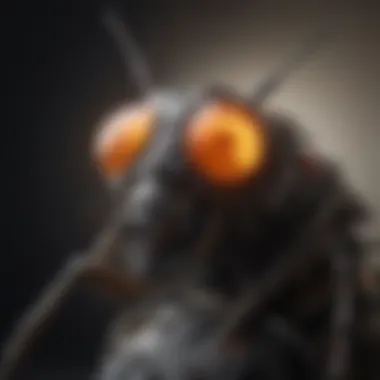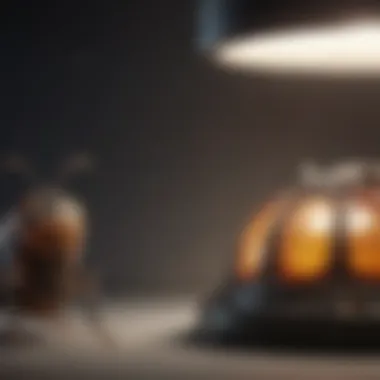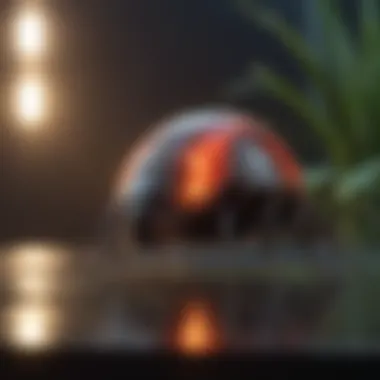Maximizing Efficiency with Commercial Bug Lights


Intro
Preventive Pest Control Strategies
House Exterior Protection
The first line of defense against pests is the exterior of your home. Sealing cracks and crevices is vital. Many bugs can find their way into your home through surprisingly small openings.
- Tips for sealing cracks: Inspect window frames, door frames, and foundation edges. Use silicone or expanding foam to seal these gaps. Ensure that vents are fitted with screens to prevent entry.
- Clearing debris: Maintain a clean perimeter around your home. Remove fallen leaves, branches, and other debris that can provide shelter for pests.
- Preventing pests from entering: Regularly check for signs of pest activity, such as droppings or nests. Consider using commercial bug lights that attract and trap flying insects, reducing their numbers around your home.
Yard Maintenance
An unkempt yard can be a breeding ground for pests. Regular maintenance is key.
- Essential yard care routines: Mow your lawn regularly and keep plants trimmed. This reduces hiding places for pests.
- Methods for keeping yard pest-free: Incorporate natural pest deterrents, such as fragrant herbs, to repel unwanted insects.
Indoor Cleanliness
A clean indoor environment is less inviting to pests. It is important to instill good cleaning habits.
- Expert cleaning tips and techniques: Regular vacuuming and dusting can significantly reduce pest populations. Pay special attention to kitchens and dining areas.
- Maintaining a pest-resistant indoor environment: Keep food sealed in containers and promptly clean up any spills or crumbs, as these can attract pests.
Garbage Disposal
Proper waste management plays an important role in pest prevention.
- Efficient waste disposal methods: Use garbage bins with tight-fitting lids to deter pests from foraging.
- Importance of proper garbage disposal: Ensure that garbage bags are not overfilled and take out the trash frequently.
Other Pest Prevention Strategies
There are additional innovative methods to safeguard your home from pests.
- Install bug lights that emit specific wavelengths that are less attractive to beneficial insects can be an effective deterrent.
- Regularly check your home to ensure that screens on windows and doors are intact. This simple step can prevent pests from easily accessing your living space.
Identifying Pest Risk Areas
Identifying potential risk areas in your home can prevent infestations before they start.
Moisture Prone Areas Inspection
- Identifying damp conditions: Look for leaks under sinks or around appliances. Pests love damp environments.
- Tips for preventing infestations: Use a dehumidifier in basements or crawl spaces if needed.
Crack and Crevice Inspection Guide
- Importance of inspecting access points: Regular inspections can help you spot vulnerabilities.
- Strategies for sealing cracks and crevices: Use caulk or other sealants to fill in gaps.
Greenery Inspection for Pest Risks
- Understanding greenery's impact on pests: Plants can attract pests if not properly maintained.
- Guidelines to maintain pest-free yards: Trim back overgrown bushes and keep trees away from the home.
Additional Pest Risk Areas
- Look at other common entry points like vents, gutters, and exterior light fixtures where pests may hide.
Effective Pest Control Methods
A variety of methods can be employed for effective pest control.
Natural Repellents for Pest Control
- Safe and effective natural solutions: Essential oils such as peppermint and lavender can deter pests.
- Use of essential oils, herbs, and plants: Planting aromatic herbs can help keep pests at bay naturally.
Chemical Sprays for Pest Control
- Safe usage of professional sprays: Always follow instructions and use in well-ventilated areas.
- Eradicating pests with chemical solutions: Target specific pest species responsibly.
Pest Traps: Effective Pest Control Solutions
- Setting up and using pest traps: Position traps in areas where you suspect activity.
- Capturing and removing pests safely: Use humane traps whenever possible.
Biological Control Methods for Pest Prevention
- Using natural predators for pest management: Ladybugs can help control aphid populations.
- Environmental-friendly pest control techniques: Focus on sustainable pest management practices.
Other Pest Control Methods
- Explore innovative technologies and products that provide effective pest solutions without harsh chemicals.
Pest Species Identification
Understanding the specific pests that may invade your home is critical for control.
Common Insects in Home Pest Control


- Be aware of common pests like ants, cockroaches, and spiders—learn how to identify and manage them effectively.
Identifying Rodents for Pest Prevention
- Tips for identifying and preventing rodent invasions: Look for droppings and gnaw marks to detect rodent activity.
Bird Species Impacting Home Environments
- Address issues related to invasive bird species and their nesting habits around your home.
Dealing with Wildlife on Your Property
- When facing wildlife such as raccoons or squirrels, understanding their behavior can guide control measures.
Miscellaneous Pest Species Identification
- Learn to identify and manage lesser-known pests, which can still present problems in homes.
DIY Pest Control Techniques
Do-it-yourself methods can empower homeowners.
Homemade Pest Control Solutions
- Eco-friendly homemade pest control remedies: Simple mixtures can be made from common household items.
Using Essential Oils for Pest Control
- Repelling pests naturally with essential oils: Create your own sprays to keep insects away.
Effective Pest Traps and Barriers
- Setting up traps and barriers for pest control: Create breaks in pest migration using barriers and traps.
Top Reputable Pest Control Brands
- Look into products from brands like Orkin, Terminix, and Raid for efficient home pest management solutions.
Miscellaneous DIY Pest Control Techniques
- Stay updated on new methods and products that offer unique solutions to pest problems.
By implementing these strategies and utilizing commercial bug lights, homeowners can protect their living spaces, ensuring a comfortable and pest-free environment. Keeping pests at bay is a continuous effort, but the results of a proactive approach are well worth it.
Understanding Commercial Bug Lights
Understanding commercial bug lights is crucial for those seeking effective solutions against unwanted pests. These lights offer a unique approach to pest control, providing both safety and efficiency. Their design and functionality set them apart from ordinary light sources. By delving into the nuances of bug lights, one can appreciate their strengths and make informed decisions about their usage in various settings.
Definition and Purpose
Commercial bug lights are specially designed lighting solutions intended to attract and eliminate insects. Typically utilizing ultraviolet (UV) light, these fixtures lure pests into traps or onto surfaces where they can be easily managed. The primary purpose of these lights is to minimize the presence of flying insects, which can be a nuisance in agricultural, industrial, or residential environments.
These lights serve multiple purposes:
- Pest Control: Their ability to draw in pests makes them a practical tool for reducing insect populations.
- Health Safety: By managing insect numbers, they contribute to a healthier environment, reducing the risk of diseases transmitted by bugs.
- Cost-Effectiveness: They are often less expensive in the long run compared to chemical pest control methods, requiring less maintenance and offering longer service life.
How They Work
Commercial bug lights operate mainly through UV light emission. This specific wavelength is particularly attractive to many flying insects. Here's how they function:
- Light Emission: The light is emitted, creating a glow that draws insects from the surrounding area.
- Attraction Toward the Light: When insects approach, they are drawn closer by the UV rays.
- Entry and Capture: Many designs incorporate mechanisms like electric grids or sticky surfaces that capture the bugs once they get too close.
Most commercial bug lights are energy-efficient, often leveraging fluorescent or LED technologies that not only reduce energy consumption but also extend the lifespan of the light. This efficiency makes them a preferred choice for various applications, striking a balance between function and sustainability.
"Effective pest management begins with understanding the tools at your disposal. Commercial bug lights represent a blend of technology and practicality in this regard."
In summary, grasping the concept of commercial bug lights enhances one’s ability to utilize them effectively. Their unique design, mechanism of action, and purpose provide an essential resource for anyone looking to manage insect populations in a comprehensive and responsible way.
Types of Commercial Bug Lights
Understanding the different types of commercial bug lights is essential for homeowners and business owners. Each type offers specific advantages and applications, catering to various needs and environments. Selecting the appropriate bug light enhances effectiveness in pest control while minimizing environmental impact.
Fluorescent Bug Lights
Fluorescent bug lights operate by emitting a soft glow, typically in the yellow spectrum, which helps attract flying insects. These lights use a gas-filled tube that illuminates when an electric current passes through it. One significant advantage is their energy efficiency compared to traditional incandescent bulbs.
Homeowners appreciate the long lifespan of fluorescent bulbs, reducing the need for frequent replacements. Furthermore, their lower heat emission protects sensitive plants and surfaces underneath. In terms of installation, fluorescent bug lights are straightforward and can be mounted in various locations.
LED Bug Lights
LED bug lights are gaining popularity due to their remarkable energy efficiency and longevity. These lights emit a spectrum that insects find less attractive, thus reducing the chances of attracting unwanted pests. Each bulb can last significantly longer than traditional lights, which is appealing for continuous use.
In addition, LED technology allows for better customization in terms of brightness and color temperature. This versatility makes LED bug lights suitable for residential patios or large commercial settings. Users benefit from a lower energy bill, while manufacturers often focus on eco-friendly components, further minimizing environmental impact.
High-Intensity Discharge Lights


High-Intensity Discharge (HID) lights include types like Metal Halide and Sodium Vapor lights. These options are well-known for their powerful illumination and long-range effectiveness. HID lighting systems are primarily used in larger commercial applications where maximum coverage is necessary.
The key differentiator is their exceptional brightness, which can illuminate large areas effectively. However, consumers should consider that HID lights require special fixtures and may consume more energy compared to LED options. Thus, balancing their high output with energy considerations is important for eco-conscious users.
In summary, selecting the right type of commercial bug light hinges on the specific needs of the space. Each category presents unique benefits tailored to different contexts, whether it be residential, agricultural, or industrial. Choosing wisely not only addresses pest issues but also contributes to overall efficiency and sustainability.
Applications of Commercial Bug Lights
The deployment of commercial bug lights stretches across various sectors, reflecting their versatility and effectiveness in managing insect populations. By employing specialized lighting techniques, these devices serve not just to attract insects, but also to minimize their detrimental impact on crops, products, and living spaces. Each application comes with distinct advantages, helping to address specific challenges effectively. Knowing where and how to use commercial bug lights is essential for achieving optimal results.
Agricultural Uses
In agricultural settings, the critical role of commercial bug lights cannot be overstated. Farmers rely on these devices to safeguard their crops from pest infestations. Pest management is a constant concern, which can lead to significant crop damage and financial losses if not monitored properly. For instance, using LED bug lights helps attract insects like moths, keeping them away from sensitive plants.
Moreover, these lights create a behavioral barrier. Crops treated with bug lights can experience a decrease in pesticide usage, as these lights can help reduce the overall insect population. It is essential to align the type of light with the specific pests targeted, ensuring that the strategy takes into account the pests' light preferences.
Industrial Applications
In industrial contexts, commercial bug lights find application in environments like warehouses and food processing facilities. Here, the presence of flying insects may compromise product integrity and hygiene. Installing these lights assists in maintaining cleanliness while deter insects from encroaching upon products.
Efficient bug lights facilitate pest monitoring, essential in compliance with health regulations. Strategically placing these lights around entry points or vulnerable areas of a facility ensures a proactive approach to insect control. Furthermore, it provides a safer workspace for employees, as traditional methods often require harmful chemicals that could lead to health risks.
Residential Implementation
Moreover, implementing durable bug lights promotes year-round outdoor enjoyment. Effective energy-efficient options contribute to long-term savings on electricity bills while ensuring effective pest control. For homeowners, understanding the selection criteria, including light spectrum and area coverage, is crucial in achieving the desired outcomes.*
"Utilizing commercial bug lights gives a significant edge in managing pest control across diverse applications, from agricultural fields to private backyards."
In summary, the applications of commercial bug lights are diverse and offer substantial benefits. Recognizing how to leverage these tools in agriculture, industry, and the home setting enhances overall effectiveness in managing and controlling insect populations.
Advantages of Using Commercial Bug Lights
Commercial bug lights provide several key advantages that distinguish them from traditional lighting options. Understanding these benefits can help in making informed decisions regarding their use in residential, agricultural, or industrial contexts. Each of these advantages serves a purpose that addresses user needs, safety concerns, and overall efficiency.
Efficiency
One of the primary advantages of bug lights is their efficiency in attracting and capturing unwanted insects. These lights use specific light spectra that are less visible to humans but highly attractive to insects. This targeted illumination significantly reduces the number of insects in a specific area. As a result, the use of commercial bug lights can lead to a decrease in pest populations without requiring harmful chemicals or pesticides.
Moreover, compared to conventional bulbs, many commercial bug lights, particularly LEDs, are more energy-efficient. They consume less power while providing the same or greater light output. This characteristic is crucial not only for lowering energy costs but also for sustaining environmental resources.
Safety
Safety is another significant advantage of using commercial bug lights. Unlike traditional bug repellents, these lights do not release harmful chemicals into the environment. This is particularly important for households with children and pets. They help maintain a pest-free area while minimizing exposure to toxic substances.
In addition, many commercial bug lights are designed with features that enhance safety during outdoor use. For example, they can come equipped with protective casings that reduce the risk of accidental breakage and are often constructed to withstand harsh weather conditions. This durability ensures that the lights do not pose a hazard to users or bystanders.
User-Friendly Design
Commercial bug lights also tend to have a user-friendly design that simplifies installation and operation. Many models are plug-and-play, meaning they require minimal setup and can be easily moved from one location to another. This portability is advantageous for users who may want to reposition the lights based on the season or specific pest problems.
Furthermore, some bug lights feature automatic sensors that facilitate their operation. These sensors can detect ambient light levels and turn the devices on or off as needed, offering convenience and eliminating the need for manual adjustments. This aspect of user-friendly design caters to a wide audience by making maintenance and operation straightforward.
Commercial bug lights combine efficiency, safety, and user-friendly features, making them an optimal choice for pest control.
In summary, the advantages of using commercial bug lights are multifaceted. They effectively reduce pests while ensuring safety and ease of use. These factors make them an attractive solution for various environments, including homes, farms, and businesses.
Considerations When Selecting Bug Lights
Selecting the right commercial bug lights involves several critical elements. Understanding these factors helps ensure that homeowners and housewives can make informed choices that result in effective insect control. The right bug light should not only attract and eliminate unwanted pests but also fit seamlessly into the user's lifestyle and environment. Here, we delve into specific considerations regarding light spectrum preferences, area coverage requirements, and durability and maintenance needs.
Light Spectrum Preferences
Light spectrum plays a crucial role in attracting specific types of insects. Insects respond differently to various wavelengths of light. Most flying insects are more attracted to UV light, which can be incorporated into commercial bug lights. Using a light that emits UV wavelengths increases the effectiveness of bug traps.
Additionally, homeowners should be aware that not all bug lights produce the same hue. Some options provide warmer colors, which might be less inviting to unwanted pests. Fully understanding how these preferences align with the types of insects present in the area can assist in choosing the most suitable product. Generally, cool white and violet spectrum lights tend to attract more bugs, while yellow and warm white lights are less attractive to them. This makes it essential to consider the intended use of the light and the insects to address.
Area Coverage Requirements
Another important consideration is the area coverage requirements. Different commercial bug lights are designed for various coverage areas, and misunderstanding this can lead to ineffective solutions. For instance, larger settings like farms or outdoor events need lights with higher coverage capabilities, often covering several hundred square feet. On the other hand, residential spaces might require localized solutions, like smaller patio lights or individual bug traps.
It is wise to consult the product specifications regarding effective range and optimal height placement. The angle and distance at which the light operates can influence its performance significantly. Selecting a light that complements the size and shape of the area ensures maximum impact in deterring pests. Without this understanding, the effort to control bugs can fall short.
Durability and Maintenance
Durability and maintenance are vital concerns when selecting commercial bug lights. Many bug lights operate outdoors and must withstand various weather conditions, including wind, rain, and temperature fluctuations. Homeowners should opt for robust materials that resist rust, corrosion, and other forms of degradation.
Maintenance is also a key aspect. Some lights require regular bulb replacements or cleaning to maintain efficiency. Evaluating the ease of access for these tasks can save significant time and effort in the long run. Therefore, it is essential to choose models that offer straightforward maintenance procedures and durable construction.
In summary, when selecting commercial bug lights, prioritize light spectrum preferences, area coverage, and durability. Making the right choice enhances pest control efforts and promotes overall satisfaction.
Choosing the right bug light is not just a matter of preference. It significantly impacts the effectiveness of pest management strategies in any residential, industrial, or agricultural setting.
Environmental Impact of Commercial Bug Lights


The environmental impact of commercial bug lights is a crucial aspect to consider for both consumers and manufacturers. As more people become conscious of their ecological footprint, understanding how these lights influence the environment becomes essential. There are specific elements to focus on, including energy consumption and the effect on non-target species. By examining these factors, one can appreciate not only the effectiveness of bug lights, but also their role in creating a more sustainable approach to pest control.
Energy Consumption
Energy consumption is a significant consideration when discussing commercial bug lights. Traditional bug lights often consume high amounts of energy, which can lead to higher electricity bills and increased carbon emissions. In contrast, newer technologies, such as energy-efficient LED bug lights, have emerged. These LEDs use significantly less energy while providing effective performance.
For instance, a standard bug light may consume around 40 watts, whereas an LED equivalent could use just 10 watts or even less. This not only reduces the energy requirements but helps diminish the strain on natural resources. Households can benefit financially through reduced energy costs and environmentally by lowering their overall energy usage.
Consumers should pay attention to the energy ratings when selecting bug lights. Look for products certified by Energy Star or comparable programs that verify energy efficiency. Choosing energy-efficient options not only ensures lower electricity expenses but actively contributes to reducing the environmental impact.
Effect on Non-Target Species
Another critical aspect of commercial bug lights is their effect on non-target species. Most bug lights are designed to attract specific pests, primarily mosquitoes. However, the use of certain light wavelengths can also attract other insects, including beneficial species. Beneficial insects, such as pollinators, play an essential role in the ecosystem, affecting plant reproduction and biodiversity.
The attraction of non-target species raises concerns about ecological balance. For instance, a substantial decline in beneficial insects may lead to reduced pollination efficiency, impacting fruit and vegetable yields. As a result, consumers and manufacturers should consider designs that minimize unintended attractions.
To mitigate negative impacts, consumers can opt for bug lights that utilize specific wavelengths designed to attract only mosquitoes. Product details often discuss the types of bugs that the lights will attract. It is wise to choose those that minimize the incidental capture of non-target species.
"Choosing lighting solutions that are mindful of the ecosystem provides an effective approach to both pest control and environmental stewardship."
Technological Innovations in Bug Lighting
In recent years, the bug lighting industry has seen significant advancements that enhance both functionality and user experience. As technology progresses, commercial bug lights have evolved, leading to innovations that offer greater efficiency and adaptability. Understanding these developments is crucial for homeowners and businesses aiming to maximize their pest control strategies while minimizing environmental impact.
Innovations in bug lighting not only improve illumination but also integrate smart features that allow users to manage systems easily. Such features reflect broader trends in technology that prioritize energy efficiency and user convenience. Here are several notable innovation areas:
- Smart Bug Lights
- Integration with IoT
Smart Bug Lights
Smart bug lights represent a substantial leap forward in how lighting can combat pests. Unlike traditional options, smart bug lights can be operated through smartphones or voice-activated devices. This connectivity offers users the ability to turn lights on or off, set schedules, and even receive notifications regarding performance issues. These features help reduce unnecessary energy consumption, which is especially important for residential or commercial settings with multiple light sources.
The benefits of utilizing smart bug lights include:
- Energy Efficiency: Smart lights often come with energy-saving modes, allowing users to adjust the intensity or operate them only when needed.
- Real-time Monitoring: Users can gain insights into how well their lights are functioning and receive alerts about replacements.
- Convenience: The ability to control lights remotely simplifies maintenance and ensures readiness without physical presence.
Integration with IoT
The integration of bug lights with Internet of Things (IoT) technology enhances their performance and user interaction. These systems can communicate with other smart home devices, facilitating an integrated approach to pest management. For example, when triggered by motion sensors, lights can automatically activate, increasing their effectiveness in catching unsuspecting insects.
Considerations for this integration include:
- Data Collection: IoT integration allows for data gathering about pest patterns, which can inform future lighting strategies or adaptations.
- User Interaction: Connective features give users more control over their environment, creating a tailored solution to pest issues.
- Scalability: As needs change, integrating new lights or additional sensors can be done seamlessly within existing systems.
"The rise in smart technology within bug lighting marks a pivotal shift towards energy efficiency and effectiveness in pest management."
Understanding these innovations enables consumers to select solutions that not only address pest concerns but also align with their values regarding energy use and environmental sustainability. As technology continues to advance, so too will the capabilities of bug lights, promising even more effective solutions for homes and businesses.
Challenges Faced in Commercial Bug Light Market
The commercial bug light market is a field that faces several challenges. By understanding these challenges, one can gain insights into the broader implications for consumers and manufacturers alike. Addressing issues such as market competition and regulatory standards can significantly impact product offerings, price points, and overall consumer satisfaction. This section aims to unfold these elements, highlighting their importance to the evolution of bug light technologies.
Market Competition
In a crowded marketplace, competition among manufacturers of commercial bug lights is intense. Various brands strive to differentiate their products. This often leads to innovations in technology and design. However, it can create confusion for consumers. With so many choices, it can be difficult for them to determine which product is suitable for their needs.
Some companies implement aggressive marketing tactics to capture market share. They highlight specifications like energy efficiency and longevity. This approach influences consumer choices, but may not always reflect the actual performance of the product.
To navigate this competitive environment, companies invest in research and development. Firms focus on enhancing the efficacy of lights in attracting and trapping pests while also minimizing the impact on non-target species. They also adopt consumer feedback to improve usability features. Ultimately, the need to stand out in the market has spurred many innovations in commercial bug lights, ensuring that consumers find value in these products.
Regulatory Standards
The bug light industry must also navigate a landscape of regulatory standards. These standards are essential to ensure that products are safe and effective. Different countries may have varying regulations regarding light emissions and materials used in manufacturing. Compliance with these regulations is crucial for manufacturers to maintain market access and consumer trust.
For instance, certain regions may impose limits on energy consumption or mandate specific labeling for consumer clarity. Adhering to these standards can require significant investment in both time and resources. Manufacturers must stay informed about changes in regulations to avoid penalties or market exclusion.
Additionally, regulatory efficiency can create both challenges and opportunities. Companies that adapt quickly may succeed in capturing niche markets that prioritize eco-friendliness and safety. It encourages businesses to innovate while upholding sustainable practices. In this context, choosing compliant bug lights becomes a priority for many consumers and businesses.
In summary, the commercial bug light market is shaped by both competition and regulatory requirements. These challenges can drive progress and innovation, ensuring that products meet consumer needs while adhering to safety standards.
Future Trends in Bug Light Technology
As the field of pest control evolves, there is an emerging focus on the future trends in bug light technology. Understanding these trends is crucial for housewives and homeowners aiming for effective pest management solutions. These advancements not only promise enhanced efficacy but also address growing concerns regarding environmental sustainability and consumer preferences.
Sustainability Initiatives
Sustainability is becoming a central theme in the design and use of commercial bug lights. More manufacturers are now producing lights that are energy efficient, thus reducing overall electricity consumption. This aligns with broader environmental goals and appeals to those who prioritize green living.
- Energy-efficient options: Many brands are developing LED technology that consumes less power while providing higher output. This reduction in energy use contributes significantly to lower bills while minimizing carbon footprints.
- Recyclable materials: The trend is also shifting towards the use of recyclable or biodegradable materials for bug lights. This helps to lessen the waste generated over the product's lifecycle and gives consumers a more responsible choice in pest control strategies.
- Reduced chemical usage: By utilizing bug lights that attract and kill pests without the use of harmful chemicals, manufacturers cater to eco-conscious customers. Such methods promote a healthier living environment for families, which is particularly important for householders.
"The integration of sustainability in bug lights is paving the way for future products that meet both performance and environmental impact demands."
Ultimately, these innovations underscore a commitment to sustainability, reducing the ecological footprint while still tackling pest issues.
Consumer Preferences Shifting
As awareness of environmental issues and health implications grows, consumer preferences are shifting. Households are increasingly inclined to select bug lights that not only serve their purpose but also align with their values and lifestyle choices.
Some notable shifts in consumer behavior include:
- Preference for smart technology: Modern homeowners are seeking devices that can integrate with smart home systems, allowing for remote monitoring and control. This can enhance convenience in managing bug control, making it more attractive for busy parents.
- Aesthetic considerations: Bug lights are no longer just functional. Consumers are interested in designs that blend with their outdoor aesthetics. Manufacturers are responding by offering a variety of styles that fit different home environments.
- Focus on health: With growing awareness regarding the potential hazards posed by conventional pest control methods, many consumers are choosing bug lights as safer alternatives. This choice often reflects a desire to protect their families and pets from exposure to harmful substances.



